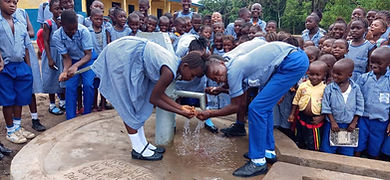




Women and girls in Africa bear the brunt of collecting water when there is no nearby source. UNICEF estimates that 200 million hours are spent by women and girls each day in water collection, "a collosal waste of time." Water collection takes valuable time away from a girls' education. Also, collecting and transporting water leaves it open to contamination of pathogens and fecal matter, causing diarrhea and other other illnesses- another reason why girls often miss school.
Here at Malimba, a school serving 400 some children, a new borehole well installed in 2021 is providing the community its first drops of water on the grounds. However, the groundwater of the school site has an iron content which was too high for consumption. The handpump method of obtaining water into buckets also allowed for contamination of pathogens.
Latrines were just installed in 2020, but there are no handwash facilities to accompany them. Serve4Good's project provided a solar pump to a 5,000 L water reservoir, a water filtration system to remove iron and pathogens to drinking water taps, and a piped handwash station near the latrines so the children can practice good hygiene, necesssary to prevent diarrhea, covid and other illnesses. The project keeps the water in a closed system from the ground until delivery at the tap, and powered only with renewable energy from the sun.
After the system was installed, we created a WASH club of girls who will help maintain and care for the water system, giving them a sense of ownership and empowerment, while learning and transmitting more knowledge about water and hygiene.



Solar-powered water pump connected to existing borehole




Water pumped up to 5000L
holding reservoir tank
2 hand wash and drinking water stations installed in front of the classsroom buildings
She Shelter girls-only cabin
for menstrual hygiene managemen
Sink for hand washing added to latrine building
The Malimba School was built by Education for All /Sierre Leone NGO:
" The Malimba village is still very isolated and access to the village remains difficult. There are about 400 children in that area and upon our first visit in 2019 there was only space to school 150. The school needed a new structure (there were only two clay classrooms for 150 children). There were no teaching/ learning materials, the children had to stand, there were not even desks and benches.
In addition, there are 7 villages around this school and these children have no access to education at all due to the lack of infrastructure and school supplies. The villagers begged us to help them because this region is completely forgotten and neglected by the Sierra Leonean government and local authorities. After our first visit, we decided to help this village. We organised the construction of a new building."
The new school has one building now which is being used for grades 1-3 , but more school classrooms are needed. The other grades still have their lessons outdoors, standing or sitting on the ground.
While Education for All will continue to concentrate on the buildings, we will undertake to help with the water supply there, which is an important component of supporting the children's learning. Without access to clean drinking water and hygiene facilities, the children are prone to dehydration, diarrhea and other illnesses which will keep them from their lessons.


The existing well which was installed in November 2021. The children were so excited for their first drops of water on the school grounds, but sadly the water quality is not drinkable. The naturally occuring iron content in the ground water is above WHO guidelines. Also, pumping water into buckets for use is also not a very hygienic method, allowing for many possiibilities for contamination. Handwash stations will prevent contamination.
